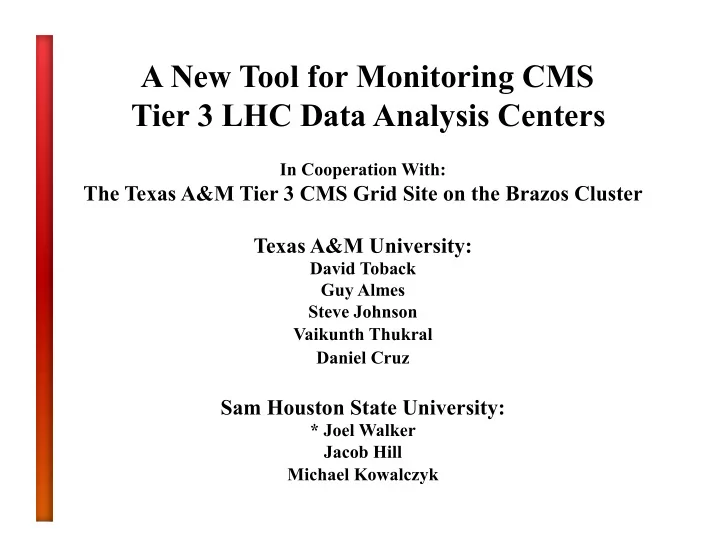

A New Tool for Monitoring CMS Tier 3 LHC Data Analysis Centers In Cooperation With: The Texas A&M Tier 3 CMS Grid Site on the Brazos Cluster Texas A&M University: David Toback Guy Almes Steve Johnson Vaikunth Thukral Daniel Cruz Sam Houston State University: * Joel Walker Jacob Hill Michael Kowalczyk
First There Was the 30 Minute Meal
After that … a bit of an Arms Race
And Now, Presenting …
Why Should You Care About this Project? • It is (mostly) Ready • It is (mostly) Working • It is (completely) Free • It is very Flexible • It is very Easy • It makes your job Easier • You can trust me • You don’t need to trust me (installs 100% locally as an unprivileged user)
A Small Cheat: The “Mise En Place”
In other Words, Prerequisites • A clean account on the host cluster • Linux shell: /bin/sh & /bin/bash • Apache web server with .ssi enabled • Perl and cgi-bin web directory • Standard build tools, e.g. make, cpan, gcc • Access to web via lwp-download or wget, etc. • Group access to common disk partition • Job scheduling via crontab • ~ 100K file inodes and ~ 2GB of disk
Ok, Let’s Start Cooking • wget http://www.joelwalker.net/code/brazos/brazos.tgz • tar –xzf brazos.tgz • cd brazos • ./configure.pl (answer two questions) • make (this takes a while) … What is it doing? • setting up your environment ( .bashrc, etc. ) • building local /bin, /lib, /include, perl5 • compiling and linking libraries ( zlib, libpng, gd, etc. ) • bootstrapping “cpanm” to load Perl modules & dependencies • creating the directory structure & moving files into place • exec bash • edit local.txt, modules.txt, alert.txt, users.txt in ~/mon/CONFIG • Test modules and set crontab to run: * * * * * . ${HOME}/.bashrc && ${BRAZOS_BASE_PATH}${BRAZOS_CGI_PATH}/_Perl/brazos.pl > /dev/null 2>&1
While that Simmers … Monitoring Goals • Monitor data transfers, data holdings, job status, and site availability • Optimize for a single CMS Tier 3 (or 2?) site • Provide a convenient and broad view • Unify grid and local cluster diagnostics • Give current status and historical trends • Realize near real-time reporting • Email administrators about problems • Improve the likelihood of rapid resolution
Implementation Goals • Host monitor online with public accessibility • Provide rich detail without clutter • Favor graphic performance indicators • Merge raw data into compact tables • Avoid wait-time for content generation • Avoid multiple clicks and form selections • Harvest plots and data with scripts on timers • Automate email and logging of errors
Email Alert System Goals • Operate automatically in background • Diagnose and assign a “threat level” to errors • Recognize new problems and trends over time • Alert administrators of threats above threshold • Remember mailing history and avoid “spam” • Log all system errors centrally • Provide daily summary reports
Monitor Workflow Diagram
View the working development version of the monitor online at: brazos.tamu.edu/~ext-jww004/mon/ The next five slides provide a tour of the website with actual graph and table samples
Monitoring Category I: Data Transfers to the Local Cluster • Do we have solid links to other sites? • Is requested data transferring successfully? • Is it getting here fast? • Are we passing load tests?
Monitoring Category II: Data Holdings on the Local Cluster • How much data have we asked for? Actually received? • Are remote storage reports consistent with local reports? • How much data have users written out? • Are we approaching disk quota limits?
Monitoring Category III: Job Status of the Local Cluster • How many jobs are running? Queued? Complete? • What percentage of jobs are failing? For what reason? • Are we making efficient use of available resources? • Which users are consuming resources? Successfully? • How long are users waiting to run?
Monitoring Category IV: Site Availability • Are we passing tests for connectivity and functionality? • What is the usage fraction of the cluster and job queues? • What has our uptime been for the day? Week? Month? • Are test jobs that follow “best practices” successful?
Monitoring Category V: Alert Summary • What is the individual status of each alert trigger? • When was each alert trigger last tested? • What are the detailed criteria used to trigger each alert?
Distribution Goals • Make the monitor software freely available to all other interested CMS Tier 3 Sites • Globally streamline away complexities related to organic software development • Allow for flexible configuration of monitoring modules, update cycles, site details and alerts • Package all non-minimal dependencies • Single step “Makefile” initial installation • Build locally without root permissions
Ongoing Work • Enhancement of content and real-time usability • Vetting for robust operation and completeness • Expanding implementation of the alert layer • Development of suitable documentation • Distribution to other University Tier 3 sites • Improvement of portability and configurability • Seeking out a continuing funding source
Conclusions • New monitoring tools are uniquely convenient and site specific, with automated email alerts • Remote and Local site diagnostic metrics are seamlessly combined into a unified presentation • Early deployment at Texas A&M has already improved rapid error diagnosis and resolution • We are engaged in a new phase of work to bring the monitor to other University Tier 3 sites
We acknowledge the Norman Hackerman Advanced Research Program, The Department of Energy ARRA Program, and the LPC at Fermilab for prior support in funding Special Thanks to: Dave Toback, Guy Almes, Rob Snihur, Oli Gutsche, and David Sanders
Recommend
More recommend